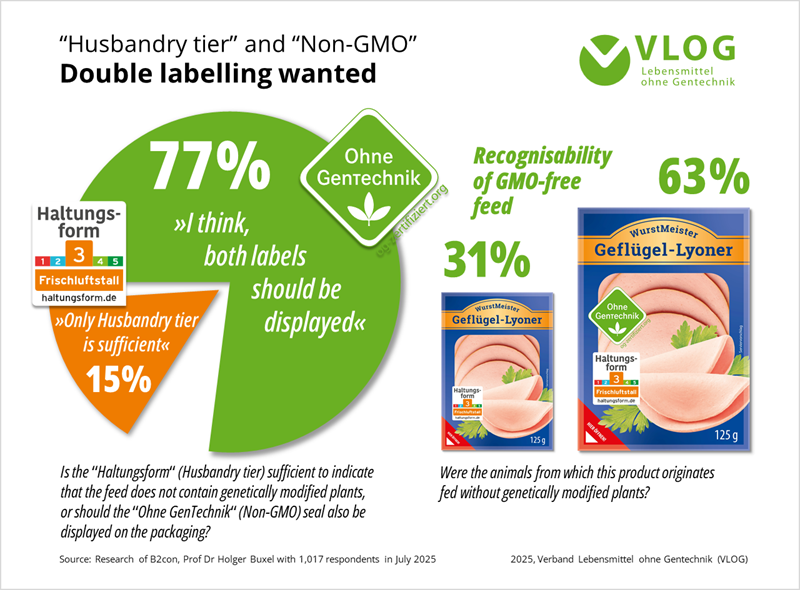News
Husbandry tier and "Ohne Gentechnik": Please show both labels!
Most fresh meat in supermarkets and major retailers today display the voluntary five-tier animal husbandry labelling system (Haltungsform) of the Society for Promotion of Animal Welfare in Livestock Farming. The higher the level, the better the husbandry conditions for the animals. In addition to sufficient space and stable or pasture husbandry, feeding also plays a role in the criteria, which vary for each animal species. Originally, from tier 3 upwards, GMO-free feeding during fattening was mandatory for all animal species in meat production. Since the end of 2024, this no longer applied to pork, and it is only now mandatory for all animal species from tier 4 onwards.
Little awareness of husbandry claims on GMO-free status
Animal welfare and "Ohne Gentechnik" are about equally important to consumers (73 and 71 percent, respectively). 79 percent would like to be able to recognise GMO-free products when shopping. This was the result of a study commissioned by the Association for Food without Genetic Engineering (VLOG) in the summer of 2025. However, only 34 percent assume that the husbandry labelling also contains information on this. And just 1 percent can correctly assign the GMO-free regulations for animal feed to the appropriate tiers.
"Ohne GenTechnik" seal doubles recognisability
The "Ohne GenTechnik" seal is perceived as significantly more suitable for easy recognisability of GMO-free products. In a dummy product test, the "Ohne GenTechnik" seal also doubled the correct classification of GMO-free products. Over three-quarters of those surveyed expressly want dual labelling with husbandry tier and "Ohne GenTechnik" and consider it resonable and helpful.
Husbandry tier and "Ohne GenTechnik" – both belong on the packaging
"The results are clear: The ‘Ohne GenTechnik‘ seal belongs on the packaging in addition to the husbandry label. GMO-free feed is and remains an important criterion for consumers when shopping for meat, just like animal welfare. Both labels together are a well-rounded solution – and explicitly what consumers want," says Alexander Hissting, Managing Director of the Association for Food without Genetic Engineering (VLOG). "The husbandry label alone is clearly not enough to identify GMO-free products. The latest changes to husbandry tier 3 make it even more difficult to understand."
Background to the market research
Prof Dr Holger Buxel from Münster University of Applied Sciences presented a comprehensive questionnaire to 1,017 people in a quota-based online survey in July 2025 on behalf of VLOG. According to the survey, 76 percent of respondents consider the "Ohne GenTechnik" seal to be useful, while 66 percent find it helpful in selecting the right products for themselves. 76 percent believe that products with GMO-free feed should be labelled with the "Ohne GenTechnik" seal.
Anuga 2025 and "Ohne Gentechnik“
"Sustainable Growth" is the main topic of Anuga, which will take place from 4 to 8 October 2025 in Cologne, Germany. "Sustainability as a driver for innovation" is one of seven food trends that will be the focus of the food fair, because "more and more people are paying attention not only to the nutritional value of their food, but also to its ecological footprint." Labels such as "Ohne Gentechnik" and husbandry tier support this.
On the opening day of the fair, the current challenges for the food industry posed by the upcoming EU regulation on new genetic engineering (NGT) will be the focus of the panel debate "New rules for new GMOs: What is in store for the organic and conventional Non-GMO sector?" on the "Organic Stage" at Anuga.

